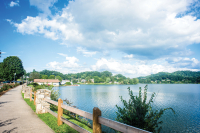Winter means waterfowl at Lake Junaluska
Anyone who follows the Naturalist’s Corner knows that I have devoted much ink to the birds one might encounter at Lake Junaluska and its environs since I began the column back in 1996.
I am sitting here looking at a species list for the lake, and it is quite impressive. I obtained the list from Jonathan Mays. Jonathan is a biologist and birder who lived a number of years in Haywood County while working for the National Park Service and the North Carolina Wildlife and Fisheries. He recently took a job with the Maine Department of Inland Fisheries and Wildlife in Bangor, Maine.
The list currently stands at 156 species and includes dozens of rarities. I will give you a taste of the list running down the families as you would likely find them in a field guide.
Gaviidae is the loon family, and the common loon is a regular migrant at the lake. The grebes make up the family Podicipedidae, and while the pied-billed grebe is a regular at the lake, the less common horned grebe is often seen sometime from winter to early spring.
The next family of birds represented at Lake Junaluska is Pelecanidae, the pelicans and there are records for both the American white pelican and the brown pelican. From pelicans we go to cormorants with the double-crested being the sole representative of the family Phalacrocoracidae. Ardeidae includes the herons and egrets. Some of the rarer records (for the mountains) include snowy egret, cattle egret and little blue heron.
The next large family of waterfowl, Anatidae, is composed of ducks and geese. Some species of mention include snow goose, Ross’s goose and the recently recognized cackling goose. The three rarest ducks are probably the scoters. Surf scoters, white-winged scoters and black scoters have all been recorded at Lake J.
Related Items
One of the newest additions to the list is the bald eagle representing the family Accipitridae. Winters and springs have also yielded merlins and peregrines from the family Falconidae.
Even cranes (Gruidae) have been recorded at Lake Junaluska. A few winters back a pen-reared sandhill crane showed up with its wild mate.
Different lake levels create different habitat, and when the lake is low during the winter and spring months, shorebirds find the mudflats. Black-bellied and American golden plovers of the family Charadriidae have been seen as well as many species of sandpipers and even willets representing the family Scolopacidae.
Nine species of gulls and terns (Laridae) have been reported at the lake. Ring-billed, herring and Bonaparte’s gulls are generally seen every year but laughing gulls and Sabine’s gulls have been documented as well as black, common, Forster’s and Caspian terns.
And just like to Capistrano, the swallows return every year. Five members of the family Hirundinidae have been observed at Junaluska. Purple martins, northern rough-winged swallows, barn swallows and tree swallows are all common summer residents. Bank swallows have also been reported.
Passerines are also prevalent around the lake. Fourteen species of warblers (Parulidae), five species of vireos (Vireonidae) and six species of blackbirds and orioles (Icteridae) have been noted.
Of course, from now until the spring migration of warblers hits next April, the main focus around Lake Junaluska will be waterfowl and shorebirds. Any weather event from now until then could produce a fallout of waterfowl. While one is more likely to find small groups of migrants, rafts of more than 200 waterfowl have been noted on the lake, and one of those was in late October.
(Don Hendershot can be reached at This email address is being protected from spambots. You need JavaScript enabled to view it..)









